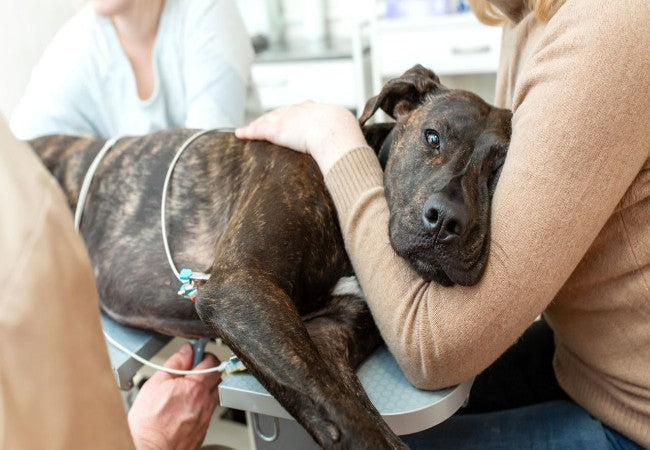Veterinary Guide to Canine Inflamed Liver Tumors 2025 🐶🎗🩺

In this article
Veterinary Guide to Canine Inflamed Liver Tumors 2025 🐶🎗🩺
By Dr. Duncan Houston BVSc
🧬 What Are Inflamed Liver Tumors?
“Inflamed liver tumors” refers to hepatic masses—both benign and malignant—that are associated with surrounding inflammatory reactions or secondary inflammation. These often include:
- Hepatocellular carcinoma (HCC): the most common primary liver cancer in dogs. Often triggers local inflammation and sometimes systemic signs.
- Bile duct carcinoma: malignant tumor of the biliary epithelium; inflammation may intensify bile stasis and cholangitis.
- Benign lesions: including adenomas, hemangiomas, leiomyomas—often with peritumoral inflammation.
- Metastatic tumors: spread from another location, often with inflammatory response or secondary hepatic injury.
👥 Who Is Affected?
- Mostly older dogs (>9–10 years), though inflammatory responses can occur at any age.
- Breeds predisposed include Retrievers, Shepherds, Poodles, and Rottweilers due to cancer risk.
- Benign tumors may be found incidentally in middle-aged dogs and provoke minimal inflammation.
⚠️ Clinical Signs
Signs are often vague and overlap with other liver diseases:
- Inappetence, weight loss, fever, lethargy, abdominal discomfort or distension (ascites).
- Jaundice due to biliary obstruction or hepatocellular damage.
- Vomiting, diarrhea, occasionally with blood.
- Neurologic signs such as hepatic encephalopathy—altered mentation, seizures.
- Palpable liver mass or enlarged liver on examination.
🔍 Diagnostic Work-Up
- History & PE: Ascites, mass effect, jaundice, abdominal pain.
- Laboratory testing: CBC, chemistry; elevated ALT/ALP/bilirubin, anemia of chronic disease; inflammatory markers may be raised; coagulation tests..
- Urinalysis: monitors renal effects, possible bile pigments.
-
Imaging:
- Ultrasound (with color Doppler): evaluates mass structure, vascularity, bile duct involvement; inflammation may appear as hypoechoic halo.
- Triphasic CT or MRI: essential for surgical planning and identifying multifocal disease.
- FNA or biopsy: core biopsy confirms tumor type and inflammatory pattern; assesses fibrosis and malignancy.
- Staging: Thoracic imaging to check metastasis if malignant; abdominal ultrasound to assess other lesions.
🛠️ Treatment Options
1. Surgical Excision
- Best for solitary, resectable masses such as massive HCC or benign lesions; liver regenerates well post-lobectomy.
- Manage inflammatory adhesions and bleeding risk; pre-op stabilization is essential.
2. Medical Therapy
- Anti-inflammatory + hepatoprotective strategies (SAMe, silybin) to mitigate peritumoral inflammation.
- Lactulose, dietary restriction, and antibiotics manage encephalopathy and biliary inflammation.
3. Chemotherapy & Targeted Therapy
- For malignant tumors: traditional chemo, multitarget TKIs like Palladia (toceranib) may help control the disease.
- Stereotactic radiation possible for unresectable focal lesions; efficacy under study.
4. Supportive & Palliative Care
- Symptomatic treatment of pain, anorexia, ascites (via low-sodium diet and diuretics), and coagulation issues.
- Frequent monitoring of labs, nutrition, quality of life; consider hospice approach when indicated.
📈 Prognosis & Outcomes
- Resectable HCC or benign tumors: excellent; survival can be years post-surgery.
- Inflamed tumors: prognosis may be worsened by surrounding tissue damage;
- Malignant tumors: nodular/diffuse forms carry guarded prognosis—6–12 mo median survival with treatment.
- Metastatic disease: poor prognosis; treatment aims for palliative control.
📱 Ask A Vet Telehealth Integration
- 📸 Share US/CT images + labs for specialist review and staging interpretation.
- 🔔 Medication, diet, and scheduled imaging reminders.
- 🩺 Virtual wound/abdominal/enclosure evaluations after surgery or injection during medical therapy.
🎓 Case Spotlight: “Luna” the Golden Retriever
Luna, a 10‑year‑old Golden, presented with weight loss and mild icterus. Ultrasound revealed a 4 cm liver mass with a hypoechoic rim. CT noted a solitary lesion, biopsy confirmed HCC with peri-tumoral inflammation. She underwent lobectomy, received SAMe/silybin, and low-dose toceranib. Ask A Vet coordinated imaging, telecheck‑ins, and med delivery via Purrz. Six months later, Luna is active, labs normal, and no recurrence on follow‑up ultrasound 🐾.
🔚 Key Takeaways
- Inflamed liver tumors include malignant and benign masses with local inflammatory responses.
- Present with nonspecific signs—jaundice, weight loss, abdominal discomfort, encephalopathy.
- Diagnosis needs imaging and biopsy; Doppler & CT help stage and plan.
- Surgery is ideal where feasible; medical, chemo, and supportive care help unresectable cases.
- Ask A Vet telehealth adds essential support—imaging reviews, treatment coordination, remote monitoring & medication delivery 📲🐾
Dr Duncan Houston BVSc, founder of Ask A Vet. Download the Ask A Vet app to support your dog with inflamed liver tumors—offerings include imaging interpretation, surgical guidance, telehealth monitoring, medication delivery, and long-term quality-of-life care 🐶📲






